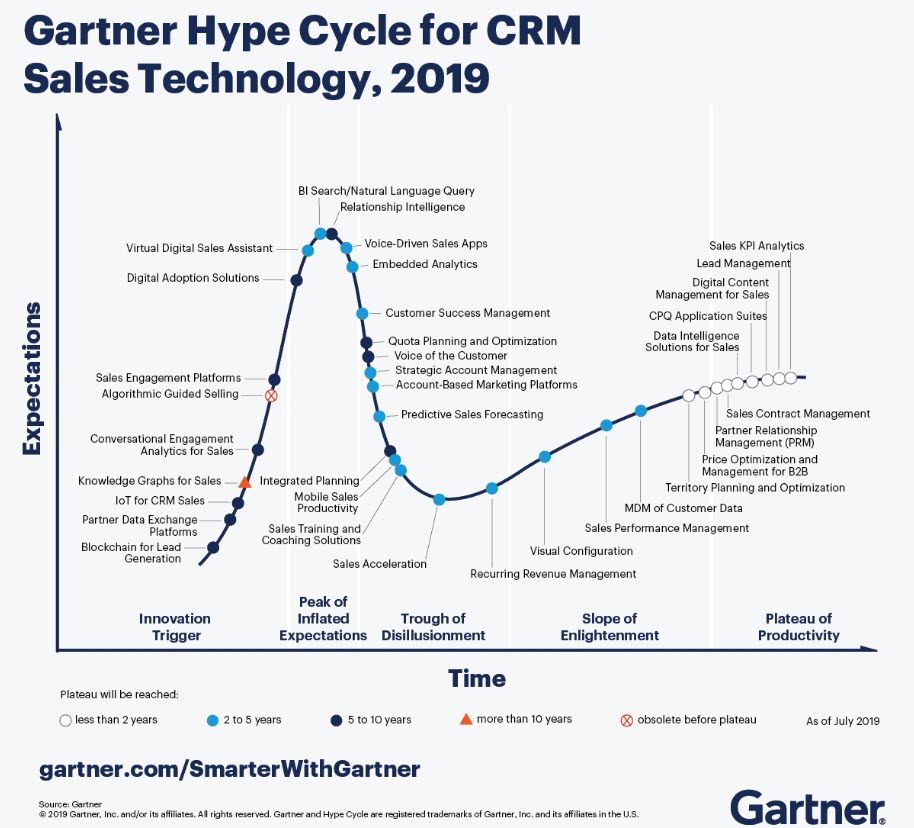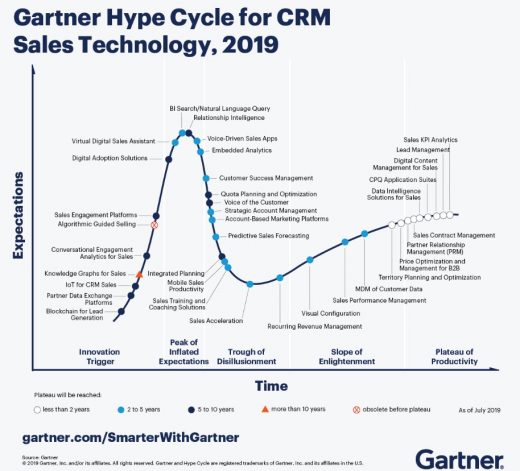What’s New In Gartner’s Hype Cycle For CRM, 2019

- Worldwide enterprise application software revenue totaled more than $ 193.6B in 2018, a 12.5% increase from 2017. CRM made up nearly 25% of the entire enterprise software revenue market.
- 72.9% of CRM spending was on software as a service (SaaS) in 2018, which is expected to grow to 75% of total CRM software spending in 2019.
- Worldwide spending on customer experience and relationship management (CRM) software grew 15.6%, from $ 41.7B in 2017 to $ 48.2B in 2018, and is projected to reach $ 55.2B in 2019.
- Salesforce dominated the worldwide CRM market with a 19.5% market share in 2018, over double its nearest rival, SAP, at 8.3% share, according to Gartner’s market share estimates.
- CRM revenue in 2018 is comprised of software and services revenue from Customer Service and Support (35.7%), Sales (25.9%), Marketing (25.4%), and Digital Commerce (13%). These four categories together comprise the customer experience and relationship management market, according to Gartner.
New technologies are proliferating across the CRM landscape, driven by the need every business has to understand, communicate, serve, and strengthen customer relationships. Gartner’s decision to create its first-ever Hype Cycle for CRM Sales Technology, 2019, reflects the widening spectrum of new technologies being introduced to improve sales effectiveness while improving operational efficiency. Gartner’s Hype Cycle for CRM Sales Technology, 2019 is based on an update to their Hype Cycle for CRM Sales, 2018. Gartner’s definition of Hype Cycles includes five phases of a technology’s lifecycle and is explained here. The Gartner Hype Cycle for CRM, 2019, is shown below:

Details Of What’s New In Gartner’s Hype Cycle For CRM, 2019
- Four new technologies are on the Hype Cycle for CRM, reflecting enterprises’ need for greater integration of diverse systems and the demand for more predictive and prescriptive analytics-based insights. The four technologies include the following:
- Blockchain for lead generation. Gartner sees the potential for blockchain to provide a decentralized peer-to-peer network model that supports exchanging data to the highest bidders using smart contracts. Gartner predicts this approach reduces or in some cases eliminates the need for a centralized authority such as a data intelligence solution. It also allows for a new ecosystem of managing, sharing and monetizing data for revenue-generating purposes.
- Knowledge graphs for sales. The ability to build an AI-enabled knowledge model of real-world entities and their relationships to one another, expressed in a data schema, shows potential to increase sales effectiveness. Gartner predicts this emerging technology provides organizations with the ability to create data-driven sales organizations using graphs arranged in a network of nodes rather than in tables of rows and columns. The significance is the ability to correlate sales activities and benchmark against performance metrics in a more digestible and insightful way, which is often too complex for human analysis.
- Digital adoption solutions. Gartner sees potential in this technology to improve the adoption of multiple tools across a selling and marketing organization. Digital adoption solutions enable sellers to onboard more quickly and improve productivity.
- Relationship intelligence. By relying on machine learning, sales organizations can map out their universe of network connections, both internal and external, to identify potential avenues of engagement with any prospect or client. Gartner sees this as useful in its ability to provide warm introductions or even referrals for revenue-generating activities while reducing sales cycles.
- Gartner predicts the following five technologies will deliver the most significant transformational benefits to selling organizations in 2 years or less. The five most transformation technologies in the near term are the following according to Gartner:
- CPQ Application Suites
- Digital Content Management for Sales
- Lead Management
- Partner Relationship Management (PRM)
- Price Optimization and Management for B2B
Sources:
4 Key Insights From the Gartner Hype Cycle for CRM Sales Technology, 2019, published October 2, 2019
Hype Cycle for CRM Sales Technology 2019, July 10, 2019 (Client access required)
(53)


